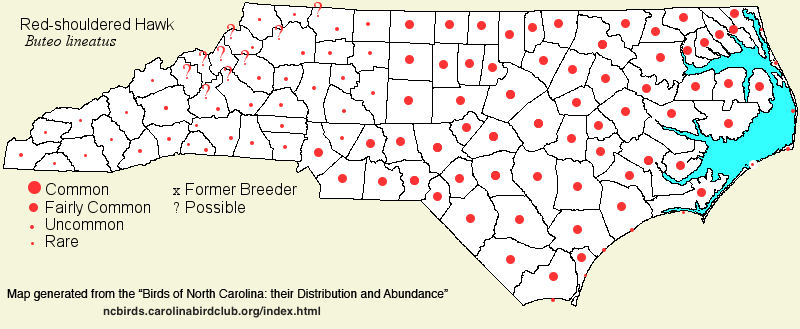 |  |
|
Red-shouldered Hawk - Buteo lineatus ACCIPITRIDAE Members: | Search Common: Search Scientific: |
|
|
|||||||
| General Comments | This familiar hawk had for many decades been less numerous or less often seen than the Red-tailed Hawk. However, the Red-shouldered's wetland habitat is not really declining, and the increase in beaver ponds is actually providing better habitat, as the hawks often feed on reptiles and amphibians at such ponds and marshes. Thus, its numbers in the state are increasing, and birds are even nesting in wooded suburban areas in cities and towns, places that they seldom or ever did a few decades ago. The species is characteristic of wetlands, being mostly found in swamps and bottomland forests, but it also forages at beaver ponds and marshes near forested areas, as well as now in wooded residential areas. It is a noisy bird during courtship, and it can often be heard (if not seen) overhead at most every swamp and bottomland in the Coastal Plain and most of the Piedmont during the spring season. | ||||||
| Breeding Status | Breeder | ||||||
| NC BRC List | Definitive | ||||||
| State Status | |||||||
| U.S. Status | |||||||
| State Rank | S5B,S5N | ||||||
| Global Rank | G5 | ||||||
| Coastal Plain | Permanent resident, with some migratory movements; slightly increasing. Fairly common to often common over most of the province, even being resident on the Outer Banks in appropriate habitat (e.g., Buxton Woods). More numerous in extensive and wide bottomlands, such as along the Roanoke, Neuse, and Lumber rivers (both at brownwater and blackwater rivers). Slightly less numerous in the Sandhills region, but still uncommon to fairly common even there. Peak counts: ? | ||||||
| Piedmont | Permanent resident, with barely noticeable migratory movements; increasing. Now fairly common to common over the province as a whole; less numerous (uncommon) in the western Piedmont, where extensive floodplains are less numerous. Peak counts: 43, Chapel Hill (spring count), 14 May 2000. | ||||||
| Mountains | Permanent resident and migrant. Rare to uncommon in the lower elevations, and very rare over about 3,000 feet, where probably only a migrant. Probably most regular in fall. Status is not well known in the region, as suitable bottomlands, swamps, and beaver ponds are rare. Peak counts: | ||||||
| Finding Tips |
This species is more easily heard than seen, as its "Kee-yar" call is often heard in swamps and bottomlands long before the bird is seen. The Roanoke River floodplain is the best area in the state for them, but one to several can usually be found in a day of birding downstate, especially in the Coastal Plain. *** to **** | ||||||
| Attribution | LeGrand[2024-02-10], LeGrand[2023-03-21], LeGrand[2012-05-19] | ||||||
| NC Map Map depicts all counties with a report (transient or resident) for the species. | Click on county for list of all known species. |
| NC Breeding Season Map Map depicts assumed breeding season abundance for the species. |  |